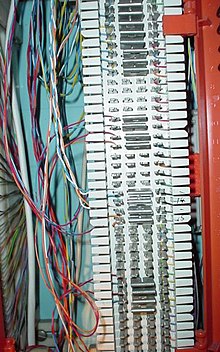This article needs additional citations for verification. (May 2022) |

A 66 block is a type of punch-down block used to connect sets of wires in a telephone system. They have been manufactured in four common configurations, A, B, E and M.[a] A and B styles have the clip rows on 0.25" centers while E and M have the clip rows on 0.20" centers. The A blocks have 25 slotted holes on the left side for position the incoming building cable with a 50 slot fanning strip on the right side for distribution cables. They have been obsolete for many years. The B & M styles have 50 slot fanning strip on both sides. The B style is used mainly in distribution panels where several destinations (often 1A2 key telephones) need to connect to the same source. The M blocks are often used to connect a single instrument to such a distribution block. The E style has 5 columns of 10 2 clips rows and are used for transitioning from the 25 pair distribution cable to a 25 pair RJ21 style female ribbon connector.
66 blocks are designed to terminate 20 through 26 AWG insulated solid copper wire or 18 & 19 gauge skinned solid copper wire. The 66 series connecting block, introduced in the Bell System in 1962, was the first terminating device with insulation displacement connector technology. The term 66 block reflects its Western Electric model number.
The 25-pair standard non-split 66 block contains 50 rows; each row has two (E) or four (M) or six (A) & (B) columns of clips that are electrically bonded. The 25-pair split 50 66 block is the industry standard for easy termination of voice cabling, and is a standard network termination by telephone companies—generally on commercial properties. Each row contains four (M) or six (B) clips, but the left-side clips are electrically isolated from the right-side clips. Smaller versions also exist with fewer rows for smaller-scale use, such as residential.
66 E blocks are available pre-assembled with an RJ-21 female connector that accepts a quick connection to a 25-pair cable with a male end. These connections are typically made between the block and the customer premises equipment (CPE).
Cite error: There are <ref group=lower-alpha> tags or {{efn}} templates on this page, but the references will not show without a {{reflist|group=lower-alpha}} template or {{notelist}} template (see the help page).